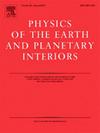最下层地幔成分和矿物学层析指标的定量评价
IF 1.9
3区 地球科学
Q2 GEOCHEMISTRY & GEOPHYSICS
引用次数: 0
摘要
大低速道(llvp)主导着地球的最下层地幔,但其详细的热化学性质仍然是一个讨论的主题。特别是,目前还不清楚在多大程度上桥方石到后钙钛矿的相变能够解释它们的地震速度特征。对这些地震结构起源的有力限制将有助于揭示大规模的地幔动力学和地球的热化学演化。在这里,我们研究了温度、化学非均质性和相变对最下层地幔层析特征的综合影响。为了研究这一点,我们利用最近的热力学数据,结合不同最低地幔温度和成分的模型,计算了一系列后钙钛矿稳定性情景下的合成地震速度。这些数据经过过滤,以解释有限的层析分辨率,从而可以将我们的合成地震速度与最近基于Backus-Gilbert的层析模型进行定量比较。至关重要的是,该模型提供了几乎相同的Vp和Vs分辨率得出的速度异常的稳健比率和相关性,并包括不确定性量化,可以解释数据和理论误差。考虑到层析成像的不确定性和有限的分辨率,我们的比较集中在全球和深度平均地震特征上,这些特征捕捉了横向成分和矿物学变异性的影响。通过拒绝不符合层析不确定度的合成模型,我们定量地消除了以下内容:(i)含有富含铁的原始成分的llvp模型,因为这些模型会产生异常高的均方根地震速度异常;(ii)在最下层地幔中没有后钙钛矿的模型,因为这些模型不能解释剪切波与压缩波速度(Rs/p)比值升高的观测结果以及剪切波与体声速(Rs−c)变化之间的负相关。此外,我们还证明,在最下层地幔中观测到的Rs/p和Rs - c不能仅用热化学llvp来解释,而需要桥菱铁矿和后钙钛矿在地幔深处共同出现。因此,我们证明了全球平均地震速度特征可以区分最下层地幔的成分和矿物学。本文章由计算机程序翻译,如有差异,请以英文原文为准。
Quantitative assessment of tomographic proxies for lowermost mantle composition and mineralogy
Large low velocity provinces (LLVPs) dominate Earth’s lowermost mantle, but their detailed thermochemical nature remains a topic of discussion. In particular, it is unclear to what extent the bridgmanite to post-perovskite phase transition is able to explain their seismic velocity characteristics. Robust constraints on the origin of these seismic structures would shed light on large-scale mantle dynamics and Earth’s thermal and chemical evolution. Here, we examine the combined effects of temperature, chemical heterogeneity and phase transitions on lowermost mantle tomographic signatures. To investigate this, we calculate synthetic seismic velocities expected from a range of scenarios for the stability of post-perovskite combined with models of different lowermost mantle temperatures and compositions using recent thermodynamic data. These are filtered to account for limited tomographic resolution, allowing for quantitative comparisons between our synthetic seismic velocities and a recent Backus-Gilbert based tomography model. Crucially, this model provides robust ratios and correlations of velocity anomalies derived from nearly identical and resolution, and includes uncertainty quantification that accounts for both data and theoretical errors. Given the tomographic uncertainties and limited resolution, our comparisons focus on globally and depth averaged seismic characteristics, which capture the effects of lateral compositional and mineralogical variability. By rejecting synthetic models that do not fit within tomographic uncertainties, we quantitatively eliminate the following: (i) models containing LLVPs with an iron-rich primordial composition, as these generate anomalously high root mean square seismic velocity anomalies; and (ii) models without post-perovskite in the lowermost mantle, as these cannot explain observations of elevated ratios of shear-wave to compressional-wave velocity () and a negative correlation between variations in shear-wave and bulk sound velocity (). Additionally, we demonstrate that observations of and in the lowermost mantle cannot be explained by thermochemical LLVPs alone, but require bridgmanite and post-perovskite to co-occur at depth in the mantle. As such, we demonstrate that globally averaged seismic velocity characteristics can distinguish between composition and mineralogy in the lowermost mantle.
求助全文
通过发布文献求助,成功后即可免费获取论文全文。
去求助
来源期刊

Physics of the Earth and Planetary Interiors
地学天文-地球化学与地球物理
CiteScore
5.00
自引率
4.30%
发文量
78
审稿时长
18.5 weeks
期刊介绍:
Launched in 1968 to fill the need for an international journal in the field of planetary physics, geodesy and geophysics, Physics of the Earth and Planetary Interiors has now grown to become important reading matter for all geophysicists. It is the only journal to be entirely devoted to the physical and chemical processes of planetary interiors.
Original research papers, review articles, short communications and book reviews are all published on a regular basis; and from time to time special issues of the journal are devoted to the publication of the proceedings of symposia and congresses which the editors feel will be of particular interest to the reader.
 求助内容:
求助内容: 应助结果提醒方式:
应助结果提醒方式:


